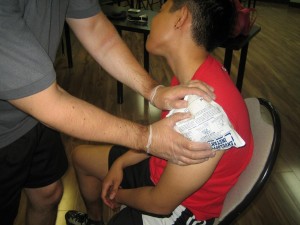Shoulder instability is generally due to trauma. The ball and socket joint of the shoulder is held in place by muscles, ligaments and bones. Once these structures are overly stretched or damaged, instability occurs.
Once dislocation occurs, the restraining structures of the joint are damaged. Contact sports such as downhill skiing and football are the usual causes of shoulder dislocation. Nevertheless, falls down the stairs, while walking along the sidewalk or off a bicycle can also lead to shoulder dislocation. In addition, some individuals are genetically predisposed to shoulder instability.
What are the indications?

The usual characteristic indication of shoulder instability is a sensation that the joint is about to move out of place or it has driven back into its socket. The sensation may or may not be accompanied by pain, but generally uncomfortable. Occasionally, the individual might also feel numbness or tingling radiating down the arm.
There is also a clicking, catching or slackness of the shoulder during daily activities and while playing sports that involve overhead throwing or swimming.
Oftentimes, the ball of the joint might separate entirely from the socket and the ball will not spontaneously move back into place. Intense pain, deformity and feeling of paralysis of the arm might occur as an outcome. The manipulation of the arm into place might require the supervision of the doctor.
Management of shoulder instability
The shoulder joint must be restored back into place immediately. Right after the injury, apply an ice pack and sling. Among young and athletic individuals, the possibility of re-dislocation is high and the risk lowers with age.
Oftentimes, shoulder instability is subtle and repeated assessments are required to confirm a diagnosis.
Medical care
Immediately after the injury, you should apply an ice pack and allow the shoulder the rest in a sling. An X-ray is usually taken to check whether any bone injury occurred due to the dislocation. After a period of rest, an exercise regimen must be started to strengthen the shoulder muscles.
Generally, a sling is used for 1-2 weeks to reduce acute shoulder pain. Once the sling is removed, the individual must avoid excessive movements over the next 4 weeks. After this period, a progressive rehabilitation program can be started.
Surgical approach
If the symptoms are continuous and disrupt with daily activities, sleeping, work or performance in sports, surgery might be required.
Surgery involves reattachment of the ripped ligament tissue to shorten or tighten the overextended ligament tissue. The approach can be carried out using open methods or arthroscopically.
After surgery, the arm is placed in a sling for 4-6 weeks. The individual is urged to keep the elbow/wrist and hand active throughout this period as the shoulder tissues heal. This is followed by physical therapy to progressively restore the range of motion and strength.
Quick Note / Disclaimer
The material posted on this page on shoulder instability is for learning and educational purposes only. To learn to recognize and manage joint injuries, register for a first aid and CPR course with Ottawa First Aid.
